

One option for delivering instruction if campuses open this fall: HyFlex. Welcome to this week's edition of "Transforming Teaching and Learning," a column that explores how colleges and professors are reimagining how they teach and how students learn.
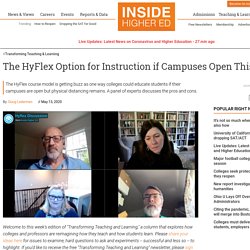
Please share your ideas here for issues to examine, hard questions to ask and experiments -- successful and less so -- to highlight. If you'd like to receive the free "Transforming Teaching and Learning" newsletter, please sign up here. And please follow us on Twitter @ihelearning. Around the country, and the world, college and university leadership teams are immersed in high-stakes discussions about whether and how to physically open their campuses to students this fall in a way that is both physically safe and educationally sound. For some institutions, those decisions could be make or break, the difference between survival and closure. Yet the countervailing pressures are significant, too. Resources on HyFlex That, potentially, is where HyFlex comes in. Hybrid model: The new normal for education will be a mix of online and in-person classes. Colleges and universities are hoping to have teachers in the classroom while K-12 schools are considering a new approach due to the coronavirus.

Almost every student around the world--from elementary school kids to college students to professionals focused on continuing education--has been learning from home since mid-March. As the current school year winds down, parents, teachers, and administrators are looking ahead to the next school year and trying to figure out what it will look like. HyFlex Course Development Guide. Student Choice, Instructor Flexibility: Moving Beyond the Blended Instructional Model. Jackie B.
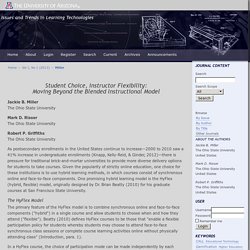
Miller The Ohio State University Mark D. Risser The Ohio State University Robert P. Griffiths The Ohio State University As postsecondary enrollments in the United States continue to increase—2000 to 2010 saw a 41% increase in undergraduate enrollments (Knapp, Kelly-Reid, & Ginder, 2012)—there is pressure for traditional brick-and-mortar universities to provide more diverse delivery options for students to take courses. What is a HyFlex course? Which is better – online learning, or face-to-face?

Torn between the two? Try a HyFlex course. A HyFlex (hybrid-flexible) course is a course that allows each individual student to choose whether they want to attend class online or in person. Students can choose their preferred method of learning on a daily basis; they can attend some sessions online, and other sessions in the classroom. The term “HyFlex” was coined by Dr. What You Should Know About HyFlex Blended Learning. Editor’s Note: We’ve been reading recently about different forms of blended learning, and stumbled upon this idea of “HyFlex” blended learning, where students combine some of the freedom of MOOCs with the in-person resources of a traditional college campus.
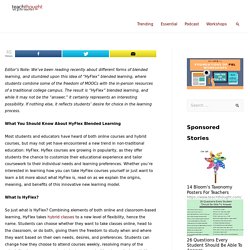
The result is “HyFlex” blended learning, and while it may not be the “answer,” it certainly represents an interesting possibility. If nothing else, it reflects students’ desire for choice in the learning process. What Is HyFlex Course Design? 7 Things You Should Know About the HyFlex Course Model. HyFlex is a course design model that presents the components of hybrid learning in a flexible course structure that gives students the option of attending sessions in the classroom, participating online, or doing both.
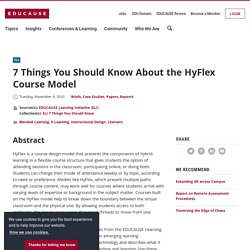
Students can change their mode of attendance weekly or by topic, according to need or preference. Models like HyFlex, which present multiple paths through course content, may work well for courses where students arrive with varying levels of expertise or background in the subject matter. Courses built on the HyFlex model help to break down the boundary between the virtual classroom and the physical one. By allowing students access to both platforms, the design encourages discussion threads to move from one platform to the other. The "7 Things You Should Know About... " series from the EDUCAUSE Learning Initiative (ELI) provides concise information on emerging learning technologies. Download PDF. Fall Scenario #13: A HyFlex Model. If there was one scenario -- besides being back to normal or fully remote in the fall -- that we hear more about than others, it would be a HyFlex Model.
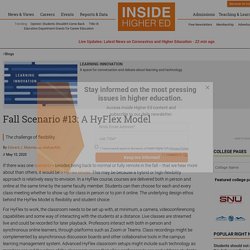
This may be because a hybrid or high-flexibility approach is relatively easy to envision. Moodle. Insidehighered. At most institutions, a face-to-face class is conducted face-to-face, and an online class is conducted online.

In blended classes, instructors mix elements of both, though students are generally expected to attend scheduled class sessions. But maybe there’s (yet) another way. Enter blendflex, an alternative mode pioneered at the two-year Central Georgia Technical College, and hyflex, an equivalent mode with a different name at the University of St. Thomas, in Minnesota. Each class in the blendflex mode has face-to-face, synchronous online and asynchronous online experiences running simultaneously. “They can seamlessly at any time during the semester move back and forth within that course delivery,” said Carol Lee, director of educational technology at Central Georgia Technical College. Origins In Georgia, the idea for this model came from a blended learning course that Lee took at the University of Central Florida in 2013.
St. "Students loved the flexibility," Hinck said. Benefits At St.